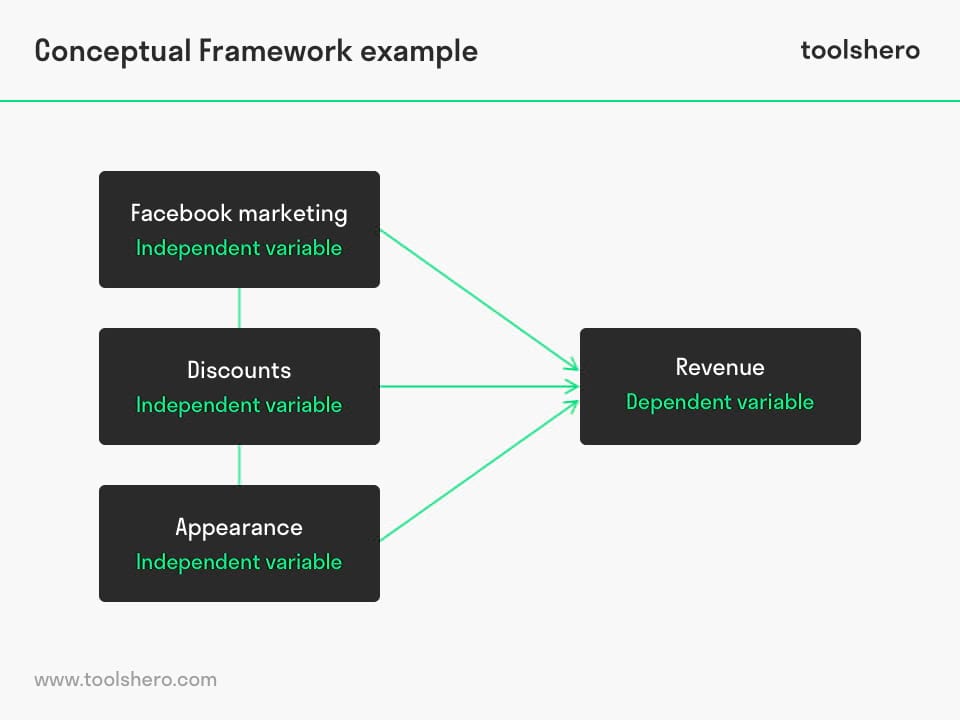Conceptual framework explained

Conceptual Framework: this article explains the conceptual framework, also called a conceptual model, in a practical way. Next to what it is (defintion and theory), also the advantages important variables combined with an example are been shared in this article. After reading it, you will understand the basics of this research and analytic tool. Enjoy reading!
What is a conceptual framework? The theory
A conceptual framework can be defined as a visual representation in research that helps to illustrate the expected relationship between cause and effect. It is also called a conceptual model or research model. That means that different variables and the assumed relationships between those variables are included in the model and reflect the expectations.
This framework is a tool that is used prior to a study. This makes a conceptual framework an analytical tool. It is used to make conceptual distinctions and bring together different ideas. Strong conceptual frameworks lead to an actual realisation of the intended objective.
Origin of the conceptual framework
A conceptual framework originates in the financial reporting of accountancy. This is a default setting for practical problems to be tested objectively.
Thus, in a conceptual framework, fundamental financial issues are dealt with, including:
- What useful features does the accounting need?
- Which basic elements are we dealing with (assets, liabilities, equity, etc.)?
- What variables are needed for the preparation of the financial statements?
A conceptual framework of a research study: purpose and importance
In a conceptual model, the relationships are clearly defined between the different variables and their relationship to each other. Typically, the model is prepared before actual research takes place.
In addition, the type of research determines whether it is wise and useful to work with a conceptual framework. In testing research, the use of a conceptual framework is customary.
Based on hypotheses, a certain idea can be shown. The basis of testing research is to demonstrate the cause effect relationship, which is also reflected in the conceptual framework. In testing research, one works with specific expectations about cause and effect relationships, which are displayed in the schematic model.
Nevertheless, the model is also suitable for exploratory research. This often consists of broadly defined concepts instead of specifically defined variables. In this type of research, the specific relationships are identified afterwards and the variables are directly measurable and formulated fairly concretely.
Research Methods For Business Students Course
A-Z guide to writing a rockstar Research Paper with a bulletproof Research Methodology!
A conceptual framework example and its variables
In order to demonstrate the cause and effect relationship well, it is important to first chart the expectations within the conceptual framework and to divide the cause-effect relationship into variables. In this context, the variables are the characteristics that summarise the cause-and-effect relationship.
Suppose it is important for a fashion chain to run more sales through their online shop.
A number of variables come together in the conceptual model: 20% more revenue through the online shop, weekly Facebook promotions, the opportunity to get an additional 10% discount on the purchase within 24 hours after a visit and an improved appearance which allows online visitors to see the clothes from various angles.
In case of the cause-effect relationship, we now deal with two types of variables: the independent variables (Facebook promotion, 10% discount and improved appearance) and the dependent variable (20% more revenue). The dependent variable (result) is determined by the independent variables (causes).
The characteristics can influence each other and be directly related to each other. If the online shop has improved its appearance, visitors will spend more time looking for clothes and they will undoubtedly also see the offer to get 10% off now. Additionally, via Facebook promotions, visitors will be drawn to the online shop.
The only discussion that can arise is which unit can best be chosen to measure the variables. Also, conceptual questions arise, such as “what is meant by Facebook promotion”. To overcome this, it is suggested to make good and clear agreements in advance.
What does that look like?
In fact, the conceptual framework is a representation of a problem statement or research question. It also looks pretty simple. Once the independent and dependent variables have been determined, a conceptual framework can be started:
- Frameworks – The dependent and independent variables are drawn up in the frames.
- Arrows – the arrows between two concepts indicate that there is a causal link; where the arrow comes from influences where the arrow points to.
- Lines – where a relationship (correlation) between 2 variables is expected, but no connection, a line is used.

Figure 1- an example of a conceptual framework
Other influencing variables
Aside from the independent and dependent variables there are other variables that can come into play that influence the relationship between the independent and dependent variables.
Three common influencing variables are moderating variables, mediating variables and control variables. Below we will briefly explain all three of them.
A moderating variable changes the effect that an independent variable has on a dependent variable, making the outcome more or less effective.
In above example, a higher discount may affect the revenue differently when a customer has a lower income, as that customer might be more susceptible to purchase items on sale. ‘Income’ or, perhaps more accurately, ‘spending power’ will then be the moderating variable.
A mediating variable connects the independent and dependent variable as an explaining factor that impacts the outcome. In the example we are using this could be the ‘number of online visitors’ of the webshop. Facebook marketing intends to draw more potential customers to the webshop and the more visitors the online shop has, the greater chance of an increase in revenue.
To help distinguish between moderating and mediating variables, consider them in relation to the independent variable. A moderating variable is namely not affected by the independent variable, whereas a mediating variable is affected by the independent variable.
In our example, ‘spending power’ is not affected by ‘discount’ and the ‘number of online visitors’ is affected by ‘Facebook marketing’.
A control variable is a variable that could affect the dependent variable, however it is held constant, so it doesn’t interfere with the outcome.
Using the same example, a control variable could be the ‘quality of internet connection’. For instance, if the website is down or customers suddenly cannot access the webshop due to a bad internet connection, this will affect the revenue.
In this case we are not interested to research the effect of the internet connection, so we keep this control variable constant. This means we only include visitors with a working connection and a webshop that is live.
The advantages of using a conceptual framework
Working with a conceptual model has various advantages. First, the user is “forced” to think carefully about the variables and give them precise descriptions.
In addition, the guidelines help you to reach a final result. The standards that are determined in advance will be consistent within this framework, so that everyone who has the variables knows exactly what is expected.
Now It’s Your Turn
What do you think? Are you using a conceptual framework in research or problem solving? Can you apply the conceptual model in today’s modern business companies? Do you recognize the practical explanation or do you have more suggestions? What are your success factors for problem analysis and researching?
Share your experience and knowledge in the comments box below.
More information
- Barick, R. (2021). Research Methods For Business Students. Retrieved 02/16/2024 from Udemy.
- Gartner, W. B. (1985). A conceptual framework for describing the phenomenon of new venture creation. Academy of management review, 10(4), 696-706.
- Seuring, S., & Müller, M. (2008). From a literature review to a conceptual framework for sustainable supply chain management. Journal of cleaner production, 16(15), 1699-1710.
How to cite this article:
Mulder, P. (2017). Conceptual framework. Retrieved [insert date] from Toolshero: https://www.toolshero.com/research/conceptual-framework/
Original publication date: 01/03/2017 | Last update: 01/02/2024
Add a link to this page on your website:
<a href=”https://www.toolshero.com/research/conceptual-framework/”>Toolshero: Conceptual framework</a>












